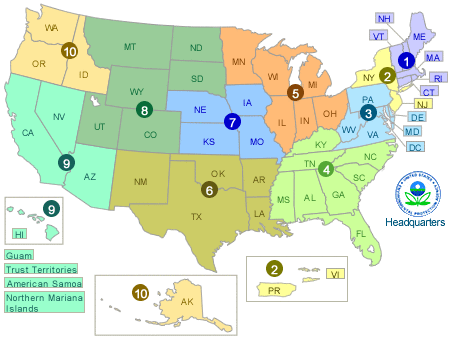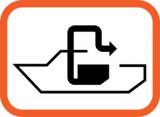Vessel Sewage Frequently Asked Questions
- Can I discharge raw sewage?

- What are the sewage discharge regulations/requirements in the United States?
- Can I discharge graywater?
- How do the different types of marine sanitation devices work?
- What chemicals can I use in my marine sanitation device?
- Can I use a composting toilet onboard my vessel?
- How do I comply with a no-discharge zone (NDZ)?
- Where can I pump out my holding tank (Type III marine sanitation device)?
- Who is my local EPA contact for vessel sewage questions?
- How do I report a vessel sewage violation?
It is illegal to discharge raw or insufficiently treated sewage within three miles from shore or within a no-discharge zone (where applicable).
What are the sewage discharge regulations/requirements in the United States?
- Section 312 of the Clean Water Act requires the use of operable, U.S. Coast Guard-certified marine sanitation devices (MSDs) onboard vessels that are equipped with installed toilets and operating on U.S. navigable waters.
- Untreated sewage discharges are prohibited within three miles from shore.
- In order to discharge within three miles, sewage must be treated using a U.S. Coast Guard-approved Type I or Type II MSD. Alternatively, sewage may be stored onboard in a holding tank (Type III MSD).
- Treated and untreated sewage discharges are prohibited in:
- Freshwater lakes, reservoirs and other freshwater impoundments whole inlets or outlets are such as to prevent the ingress or egress by vessel traffic.
- Rivers not capable of navigation by interstate vessel traffic.
- No-discharge zones (NDZs) (as applicable).
- In these areas, sewage effluent generally must be retained onboard in a holding tank (Type III MSD). Operators of vessels equipped with flow-through MSDs (Type I or Type II) must secure the device to prevent overboard discharge.
- Visit the No-Discharge Zones (NDZs) by State webpage for more information on the location and applicability of NDZs.
Can I discharge graywater from my vessel?
Graywater is regulated differently depending on the type of vessel and whether it is mixed with sewage effluent. Commercial and military vessels have graywater requirements under the National Pollutant Discharge Elimination Systems (NPDES) permitting regime and the Uniform National Discharge Standards, respectively. For recreational vessels, there are currently no federal rules in place regulating graywater.
For all vessels, when graywater and sewage are mixed, the resulting discharge must meet sewage effluent requirements.
How do the different types of marine sanitation devices work?
There are three types of marine sanitation devices (MSDs): Type I, Type II and Type III.
Type I MSDs are flow-through devices, which are suitable for vessels up to 65 feet in length. These devices use a combination of maceration and disinfection to treat vessel sewage. After pulverizing the solids, the effluent is exposed to disinfectants (often, chlorine tablets) that reduce bacteria levels to below the established limits under the Clean Water Act. In some cases, bactericide can be generated from the saltwater using special electrodes, so that no added disinfectant products are needed.
Type II MSDs are flow-through devices suitable for larger vessels. Type II devices are biological systems. First, sewage is aerated so that the bacteria already present in the sewage can thrive and begin to consume/break down the sewage as their food supply. As with the Type I devices, the remaining liquid waste is then treated via contact with chlorine tablets, UV disinfection, or other methods of disinfection. Overall, Type II devices can achieve better treatment levels than Type I devices because of the biological component of the system, as opposed to maceration.
Type III MSDs are holding tanks which do not treat sewage onboard the vessel. These devices are designed to store sewage effluent while preventing overboard discharge.
What chemicals can I use in my marine sanitation device?
Not all marine sanitation devices require the use of chemicals for day-to-day operation. Those that do most likely rely on chlorine to treat the sewage effluent. Each device should be maintained as described in its manual, as each type-approved system is unique. For systems which use chlorine, generally the owner is responsible for maintaining the proper amount of chlorine tablets in the system. Most manuals advise that the owner check on a weekly-to-biweekly basis during the system's regular use to ensure effective treatment.
Can I use a composting toilet onboard my vessel?
Composting toilets may be considered a Type III marine sanitation device by the U.S. Coast Guard. Type III devices that store sewage and flushwater at ambient air pressure and temperature are not subject to formal certification by the U.S. Coast Guard, as long as the device complies with the following requirement: "Be designed to prevent the overboard discharge of treated or untreated sewage or any waste derived from sewage (Type III)." Please note that most composting toilets have not been examined by the U.S. Coast Guard. Instead, in most cases, the device manufacturer attests that the device meets the aforementioned requirements.
The contents of both the liquid waste container and the compost chamber must be properly disposed of such that no overboard discharge occurs.
See 33 CFR 159.12(a) and 33 CFR 159.53(c) for the relevant statutory language.
How do I comply with a no-discharge zone?
While operating in a no-discharge zone, overboard discharge from marine sanitation devices is generally prohibited. To secure a flow-through device (i.e.,. Type I or Type II marine sanitation device), vessel operators must do one of the following:
- Close the seacock and remove the handle;
- Padlock the seacock in the closed position;
- Use a non-releasable wire-tie to hold the seacock in the closed position; or
- Lock the door to the space enclosing the toilet(s) with a padlock or door handle key lock.
See 33 CFR 159.7(b)-(c) for the relevant statutory language.
Where can I pump out my holding tank (Type III marine sanitation device)?
Holding tanks must be pumped out at an appropriate onshore or mobile (i.e., truck or boat) facility. Contact your local marina or marina organization to find out which facilities have the required equipment. Many state agencies also maintain information on pumpout facility locations.
Who is my local EPA contact for vessel sewage questions?
For questions related to vessel sewage discharges and no-discharge zones in your area, you may contact the following EPA staff.

| EPA Region | Contact |
|---|---|
|
Region 1
|
Ivy Mlsna, mlsna.ivy@epa.gov
|
|
Region 2
|
Moses Chang, chang.moses@epa.gov
|
|
Region 3
|
Michael Hoffmann, hoffmann.michael@epa.gov
|
|
Region 4
|
|
|
Region 5
|
Wilonda Quinn, quinn.wilonda@epa.gov
|
|
Region 6
|
|
|
Region 7
|
Alex Owutaka, owutaka.alex@epa.gov
|
|
Region 8
|
Amy Clark, clark.amy@epa.gov
|
|
Region 9
|
Allan Ota, ota.allan@epa.gov
|
|
Region 10
|
Catherine Gockel, gockel.catherine@epa.gov
|
|
Headquarters
|
Kelsey Watts-FitzGerald, watts-fitzgerald.kelsey@epa.gov
|
How do I report a vessel sewage violation?
Violations of vessel sewage regulations should be reported to your local U.S. Coast Guard office or National Response Center, as well as to your local marina (if appropriate).
As described on the U.S. Coast Guard's website, "Effluent discharged from a vessel that does not meet EPA's published standard subjects the vessel owner or operator to civil penalty of up to $2,000 for each violation" under 33 U.S.C. 1322(j). "If you witness a vessel discharge raw or untreated sewage inside U.S. waters or if you see a visible floating solid in the waste stream, then you are encouraged to report it to your nearest Coast Guard office or to the National Response Center 24-hours a day."
Visit the U.S. Coast Guard's website to see which District covers your location.
You may also report a violation to your state environmental agency in order to be connected to the appropriate local enforcement authority.

